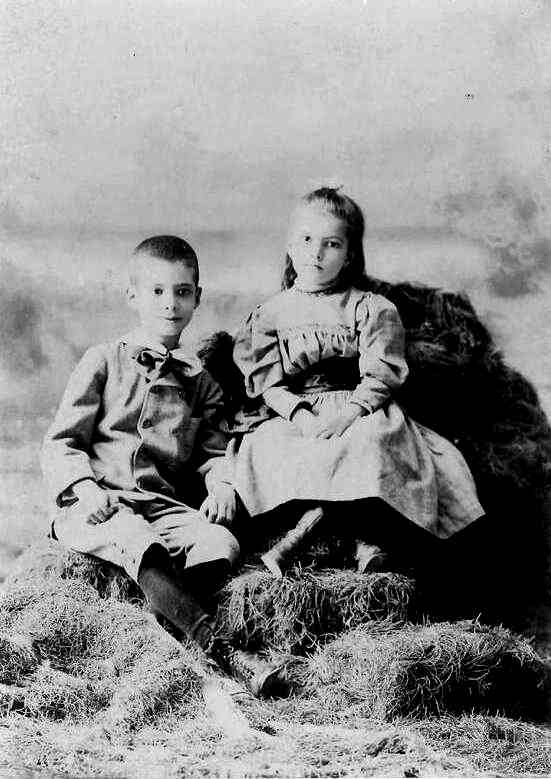
National Boys' Clothes: El Salvador

Figure 1.--The cabinent card portrait hows a brother and sister, we think in the 1880s. If we did not know that it was taken in El Salvador, probably San Salvador, we would have guessed that it was American. This suggests that children in the privlidged classes dressed much like American children. Despite the warm tropical climate, the children are even wearing long stockings.
|
|
El Salvador is a small Central American country wedged between Guatemala and Homduras. It is the only exclusively Pacific-coast Central American country. It was within the rannge of the classical Mayan civilization. Modern El Salvasor is a largely mestizo country (about 90 percent). Very few Salvadorans are pure blood Native Americans. El Salvador achieved independence from Spain (1821) and became involved with both Mexico and a Central ASmerican Federation. The country subsequently became an independent country (1839). Since that time it has had a unstable national existance, often dominated by military dictatorship. Like mny Latin American countries, the ecomnomny has beebn domimnated by commoidities, in the case of El Salvador it has been coffee. Most recently, El Salvador experiebced a 12-year civil war, ewsulting in the loss of about 75,000 lives. The war was ended when the government and leftist rebels signed a treaty that provided for military and political reforms (1992). We have very limited information about El Salvador at this time. The one photograoh we do have shows a brother and sister, we think in the 1880s. If the did not know that it was taken in El Salvador, probably San Slvador, we would have guessed that it was American. This suggests that children in the privlidged classes dressed much like American children. Despite the warm tropical climate, the children are even wearing long stockings. Most Salvadorian boys until after Wotld War II wore light-colored shirts and light colored long trousers, a kind of compesino dress common throughout Latin America.
Geography
El Salvador is a small Central American country wedged between Guatemala and Homduras. It is the only exclusively Pacific-coast Central American country. The country from west to east is divided by two roughly parallel volcanic ranges. Between thesecranges are vallys with grasslands excellent for raising cattle.
Modern El Salvasor was on the southern fringe of Mesoamerican and the Mayan cultural zone. The Spanish conquest of the Native American tribes in El Salvador was conducted in conjunction with the conquest of the tribes in Guatemala. Modern El Salvador during the Spanish colonial period was part of the Captaincy of Guatemala. El Salvador achieved independence from Spain (1821). Mexico's short term Emperor, Iturbide, folded in Central America to his Mecican Empire. When this disolved, El Salvador joined the Central American Federation (1825-38). With the break up of the Federation, the country became independent (1838).
Since that time it has had a unstable national existance, often dominated by military dictatorship. Coffee was introduced as a commercial crop (mid-19th century). It proved very successful and, as a result, there was a substantial increase in population. The country todays has the highest population density in Central America. General Martinez seized control of thegovernment (1931) and attempted to destroy the Communist Party and teir supporters. He openly supported Fasists in Europe, but by the time pf Pearl Harbor joined the other Latin American countries in U.S,-promoted hemispheric solidarity against the Axis. A left-wing military junta seized control of the government (1960). A more moderate military government replaced it (1961). An elected president, Julio Adalberto Rivera, was elected (1962). Most recently, El Salvador experienced a vicious 12-year civil war, resulting in the loss of some 75,000 lives. The war was ended when the government and leftist rebels signed a treaty that provided for military and political reforms (1992).
Economy
Like mny Latin american countries, the economy has been domimnated by commodities. El Salvador is a primarily agricultural country. The farm land is rich and well watered, but the sunstantial population growth since the intriduction of coffee (mid-19th century) means that much of the rural population does not own land. Coffee rapidly became the single most important crop. Cotton, another introduced crop, is also of some importance.
Ethnicity
Modern El Salvasor has a largely homogeneous mestizo (ladino) population (about 90 percent). Relatively few Salvadorans are pure blood Native Americans and this portion is declining.
Garments
We have very limited information about El Salvador at this time. The one photograoh we do have shows a brother and sister, we think in the 1880s. If the did not know that it was taken in El Salvador, probably San Slvador. we would have guessed that it was American. This suggests that children in the privlidged classes dressed much like American children. Despite the warm tropical climate, the children are even wearing long stockings. Most Salvadorian boys until after Wotld War II wore light-colored shirts and light colored long trousers, a kind of compesino dress common throughout Latin America.
We are just beginning to acquire information about the activitoies pursued by Salvadoran children. icultural country with mos children growing up in the countryside. This mean from an early age that they were involved in farm life and of course chores. We do not have any informastion on games played by Salkvadoran children. The important holidays are religious (Christmas and Eater) and Independence Day.
The educational system was poorly developed until after World war II. Most Salvadoran childen asre Catholic. Most children have a First Communion. There is a small Scouting movement. Sports are also a relastively recent phenomenon. The principal sport in El Salvador is football which has become a national obssession throughout Latim America.
HBC

Navigate the Boys' Historical Clothing Web Site:
[Return to the Main Latin American page]
[Return to the Main countries page]
[Introduction]
[Activities]
[Biographies]
[Chronology]
[Cloth and textiles]
[Clothing styles]
[Countries]
[Topics]
[Bibliographies]
[Contributions]
[FAQs]
[Glossaries]
[Images]
[Links]
[Registration]
[Tools]
[Boys' Clothing Home]
Created: 8:16 AM 1/29/2008
Last updated: 5:30 AM 11/23/2011



